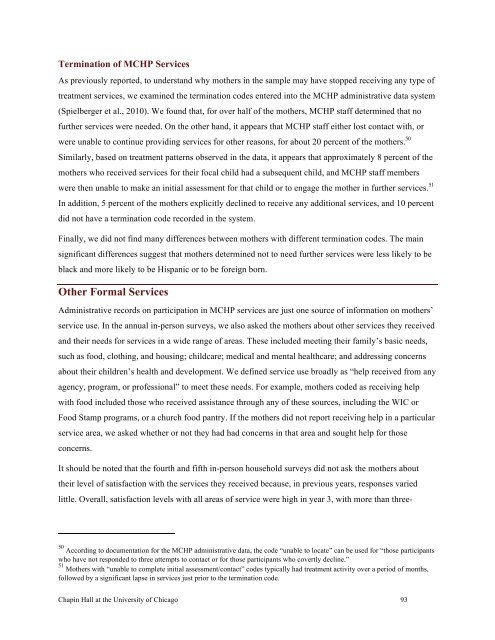2011 The Palm Beach County Family Study (Full Report)
2011 The Palm Beach County Family Study (Full Report)
2011 The Palm Beach County Family Study (Full Report)
- No tags were found...
You also want an ePaper? Increase the reach of your titles
YUMPU automatically turns print PDFs into web optimized ePapers that Google loves.
Termination of MCHP ServicesAs previously reported, to understand why mothers in the sample may have stopped receiving any type oftreatment services, we examined the termination codes entered into the MCHP administrative data system(Spielberger et al., 2010). We found that, for over half of the mothers, MCHP staff determined that nofurther services were needed. On the other hand, it appears that MCHP staff either lost contact with, orwere unable to continue providing services for other reasons, for about 20 percent of the mothers. 50Similarly, based on treatment patterns observed in the data, it appears that approximately 8 percent of themothers who received services for their focal child had a subsequent child, and MCHP staff memberswere then unable to make an initial assessment for that child or to engage the mother in further services. 51In addition, 5 percent of the mothers explicitly declined to receive any additional services, and 10 percentdid not have a termination code recorded in the system.Finally, we did not find many differences between mothers with different termination codes. <strong>The</strong> mainsignificant differences suggest that mothers determined not to need further services were less likely to beblack and more likely to be Hispanic or to be foreign born.Other Formal ServicesAdministrative records on participation in MCHP services are just one source of information on mothers’service use. In the annual in-person surveys, we also asked the mothers about other services they receivedand their needs for services in a wide range of areas. <strong>The</strong>se included meeting their family’s basic needs,such as food, clothing, and housing; childcare; medical and mental healthcare; and addressing concernsabout their children’s health and development. We defined service use broadly as “help received from anyagency, program, or professional” to meet these needs. For example, mothers coded as receiving helpwith food included those who received assistance through any of these sources, including the WIC orFood Stamp programs, or a church food pantry. If the mothers did not report receiving help in a particularservice area, we asked whether or not they had had concerns in that area and sought help for thoseconcerns.It should be noted that the fourth and fifth in-person household surveys did not ask the mothers abouttheir level of satisfaction with the services they received because, in previous years, responses variedlittle. Overall, satisfaction levels with all areas of service were high in year 3, with more than three-50 According to documentation for the MCHP administrative data, the code “unable to locate” can be used for “those participantswho have not responded to three attempts to contact or for those participants who covertly decline.”51 Mothers with “unable to complete initial assessment/contact” codes typically had treatment activity over a period of months,followed by a significant lapse in services just prior to the termination code.Chapin Hall at the University of Chicago 93
















